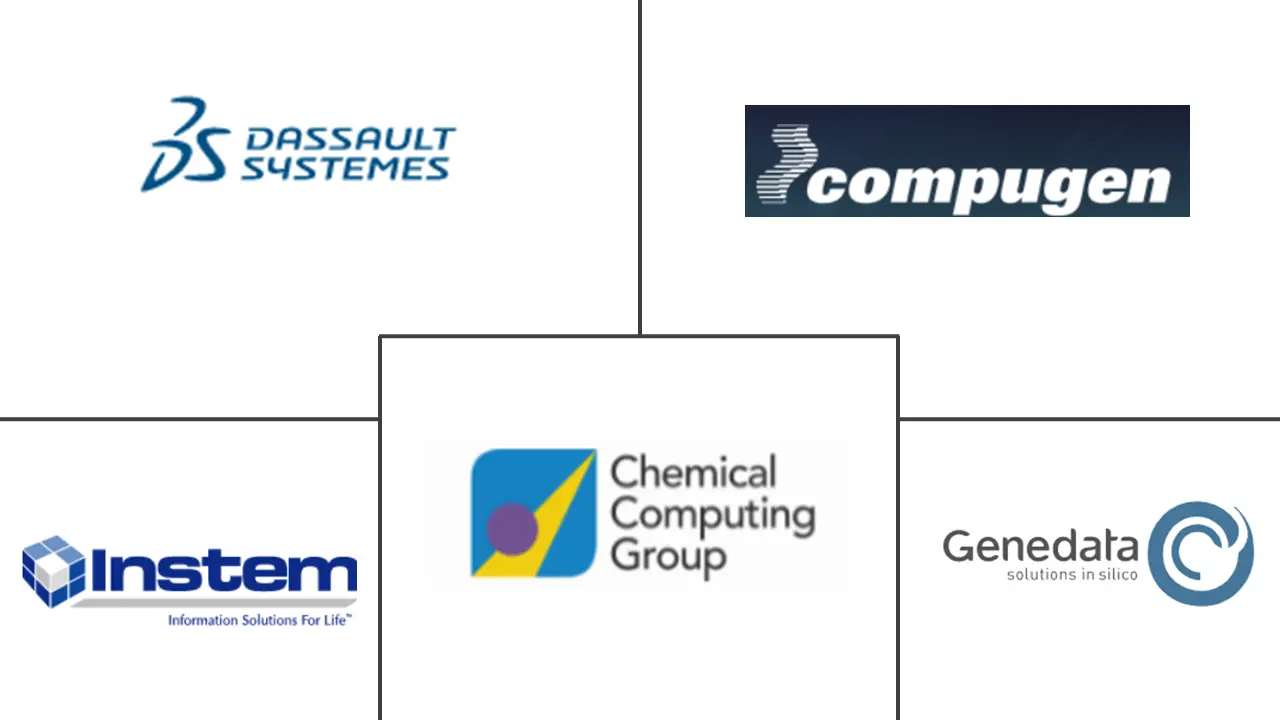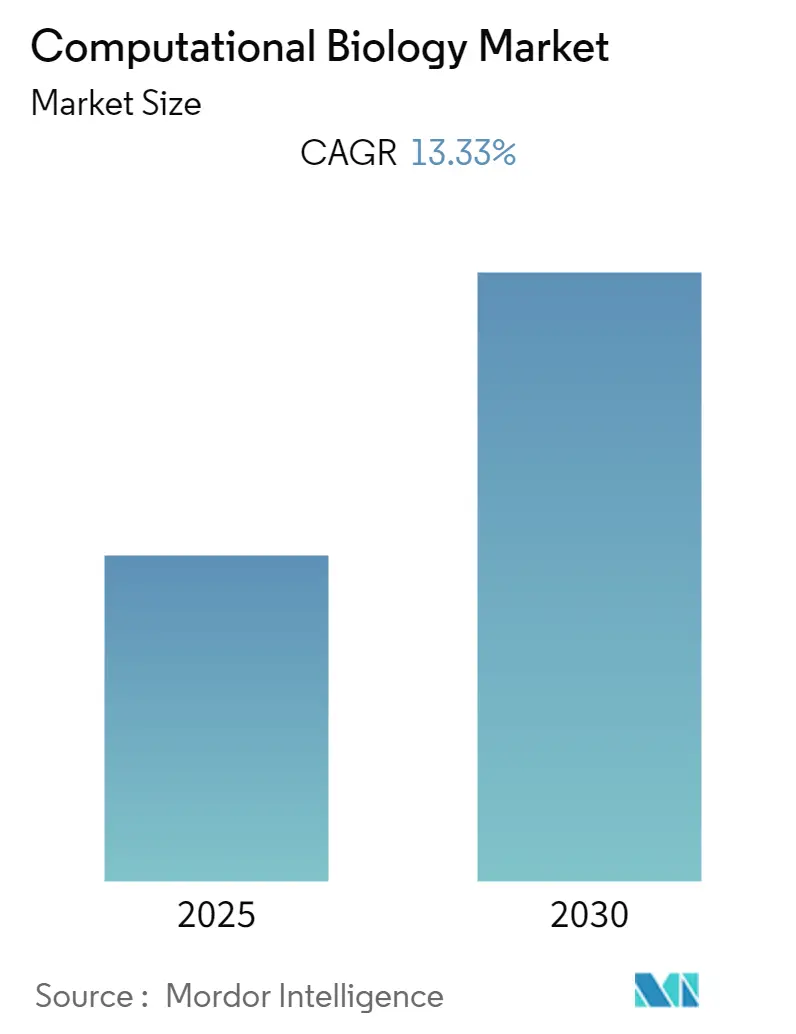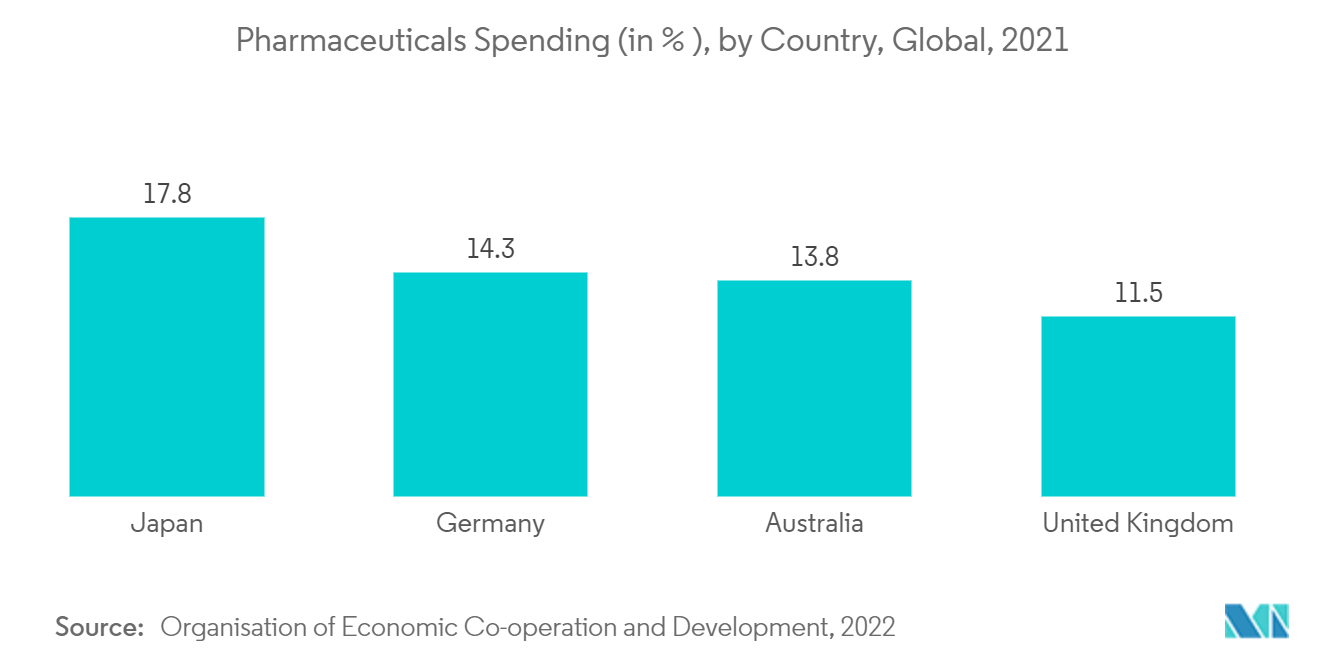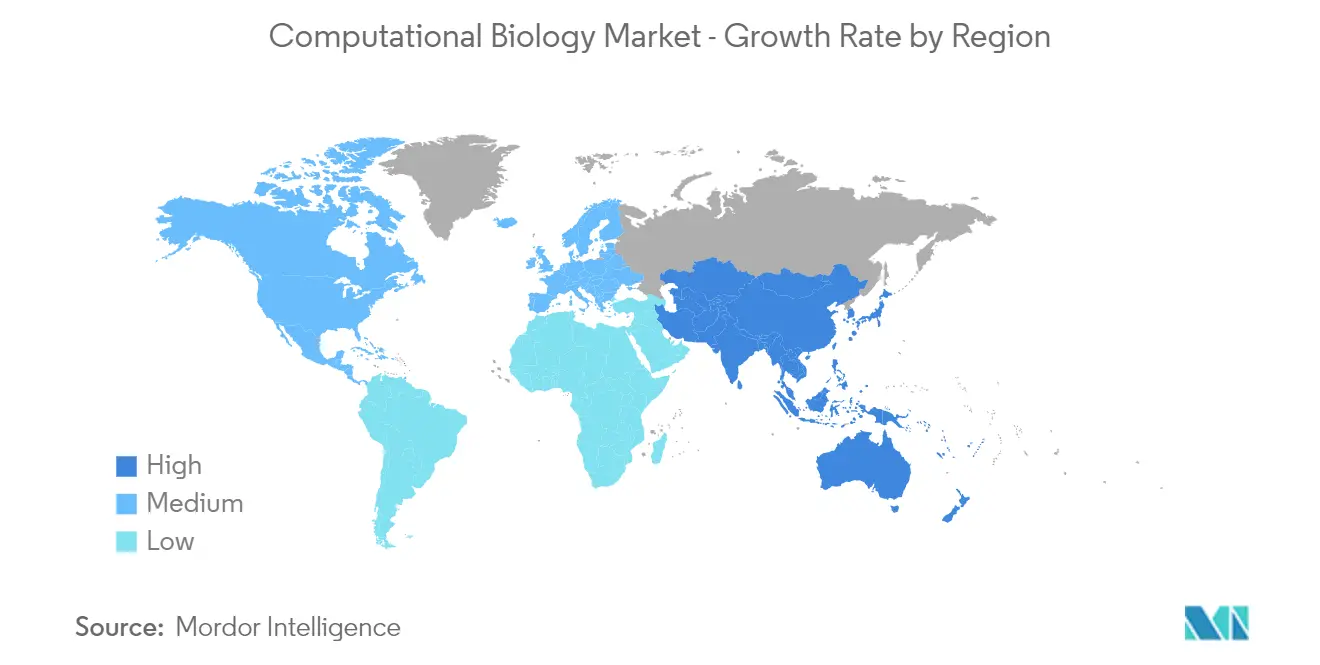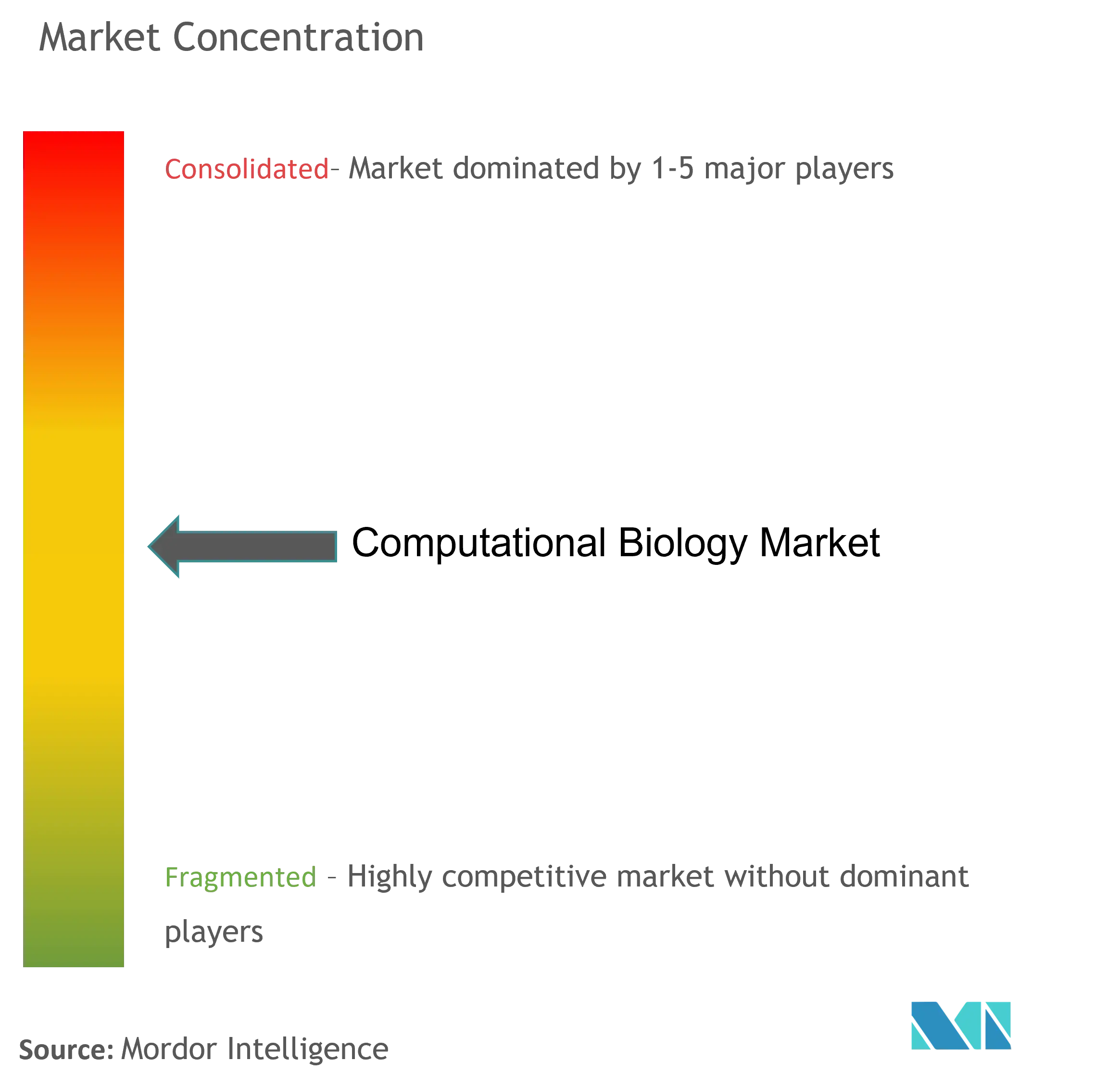Computational Biology Market Analysis
The Computational Biology Market is expected to register a CAGR of 13.33% during the forecast period.
The COVID-19 pandemic impacted the computational biology market significantly. In addition to expediting the discovery of the genome and protein structure, variant calling, mutation, and other biological aspects of SARS-CoV-2, computational biology was helpful in various other ways. Bioinformatics research facilitates the search for evidence of the viral origin, host, and evolution. Aside from that, bioinformatics methods like molecular docking, molecular dynamics simulation, and artificial intelligence (AI) technologies were thought to speed up the search for novel drugs for COVID-19 infection. For instance, as per the review article published in the Briefings in Bioinformatics Journal in March 2021, the ARTIC network, which has vast experience and skill in using this technology in the sequencing and surveillance of outbreaks, including Zika and Ebola, has created and optimized the SARS-CoV-2 nanopore sequencing procedure. Nanopore sequencing is used to create SARS-CoV-2 genomes with high accuracy and to monitor COVID-19 transmission as well as viral development over time. Hence, developments and research in computational biology increased during the pandemic and fueled the growth of the market studied. This is further anticipated to drive the market's growth over the forecast period.
Factors such as an increase in bioinformatics research, an increasing number of clinical studies in pharmacogenomics and pharmacokinetics, and the growth of drug designing and disease modeling are anticipated to contribute to the growth of the computational biology market over the forecast period.
Bioinformatics is recognized as part of the essential knowledge base of numerous biomedical research and healthcare career paths. Bioinformatics and computational biology have undergone several transformations over the decade and established themselves as key components of new biology. For instance, per the data the Department of Biotechnology (DBT) updated in February 2022, the expansion of sequence databases due to genome sequencing initiatives has increased the demand for bioinformatics tools and knowledge. In addition, as per Johns Hopkins University data updated in January 2023, computational medicine has advanced in healthcare by creating computational models of disease, personalizing these models with patient data, and using these models to enhance disease diagnosis and treatment. Thus, the rising demand for genome sequencing and the adoption of computational methods in healthcare is anticipated to fuel the growth of the studied market over the forecast period.
Moreover, recent improvements in bioinformatics include capacity-building through activities such as research funding and training opportunities. Increased funding in bioinformatics is helping to create more advancements in computational biology. For instance, in July 2022, a former executive at Pfizer and Bristol-Myers Squibb, Adrian Woolfson, reported USD 55 million of seed funding to reprogram biology and create next-generation genomic products. Therefore, the increased research funding for the development and research of new methods in computational biology is expected to boost the growth of the studied market during the analysis period.
However, the lack of trained professionals is a major factor expected to hinder the market's growth.
Computational Biology Market Trends
Industry and Commercials Sub-segment is Expected to hold its Highest Market Share in the End User Segment
The industry and commercials segment is expected to grow during the analysis period. Rising governmental and commercial sector investments in Research and Development (R&D) in genetic engineering and novel medicine development significantly contribute to the rise in demand for computational biology.
As per an update by WHO in May 2021, WHO and the Swiss Confederation signed a Memorandum of Understanding (MoU) to launch the first WHO BioHub Facility as part of the WHO BioHub System; the facility was established in Spiez, Switzerland, and serves as a center for the safe receipt, sequencing, storage, and preparation of biological materials for distribution to other laboratories; and informs risk assessments and supports global preparedness against pathogens.
In addition, in February 2023, Hexagon Bio raised USD 77.3 million in Series B financing. It strengthened its management to advance microbial genome-derived small molecules and expand a novel computational discovery platform. Hexagon's interdisciplinary platform enables broad opportunities across multiple therapeutic areas, including oncology and infectious diseases. Hence, these developments and investments in the segment are expected to fuel the segment's growth over the forecast period. Therefore, this is expected to support the growing demand for computational biology and drive revenue growth.
North America is Expected to Hold a Significant Share of the Market Over the Forecast Period
North America currently holds a significant share of the market for computational biology and is expected to continue its stronghold for a few more years. Factors such as increasing funding and investments and engagement of market players in computational biology are anticipated to fuel the region's studied market growth.
The United States is one of the major countries significantly promoting and supporting computational biology developments through various investments and funding; hence, the market is growing efficiently. For instance, per the National Science Foundation (NSF) Budget Request to Congress for 2022, NSF plans to keep funding computational biology and bioinformatics to address the computational and data-science problems that arise in biotechnology studies. To support the expansion of United States biotechnology innovation, NSF is willing to use investments in data analytics and computation, artificial intelligence (AI) and machine learning, physical infrastructure, and others. Thus, the engagement of government organizations in the investments is expected to drive innovations in the computational biology market and fuel the market's growth.
Additionally, personalized medicine has increased collaborative efforts between medical institutions, governments, and researchers to swiftly develop effective treatments. For instance, in July 2021, Indivumed GmbH launched Travel, a unique AI discovery platform for oncology and precision medicine. The platform combines IndivuType's deep multi-omics data with elaborate disease models, high-powered automated Machine Learning tools, and a comprehensive suite of advanced analytics tools.
In addition, in April 2023, the Icahn School of Medicine at Mount Sinai and Rensselaer Polytechnic Institute opened a research center combining engineering and precision medicine. Researchers of these centers will focus on advancing point-of-care and point-of-use devices and diagnostic tools in drug development, stem cell applications, cellular engineering, and computational neurobiology. These developments are further expected to accelerate the growth of the overall computational biology market in the region.
Therefore, the computational biology market in the region is predicted to witness growth over the forecast period, primarily due to high expenditure on drug development endeavors in the countries across the region.
Computational Biology Industry Overview
The computational biology market is competitive, and it is expected to witness more competition in the near future. The market consists of several major players, and new entrants are also entering and expanding the market competitiveness. With increasing technological advancements and product innovations, mid-size to smaller companies increase their market presence by introducing new products at lower prices. Companies like Dassault Systèmes, Chemical Computing Group Inc., Instem Plc. (Leadscope Inc.), Compugen Ltd. and Certara hold considerable shares in the market.
Computational Biology Market Leaders
-
Dassault Systèmes SE
-
Chemical Computing Group ULC
-
Genedata AG
-
Instem PLC
-
Compugen Ltd
- *Disclaimer: Major Players sorted in no particular order
Computational Biology Market News
- February 2023: The Centre for Development of Advanced Computing (C-DAC) launched two software tools critical for research in life sciences. Integrated Computing Environment, one of the products, is an indigenous cloud-based genomics computational facility for bioinformatics that integrates ICE-cube, a hardware infrastructure, and ICE flakes. This software will help securely store and analyze petascale to exascale genomics data.
- January 2023: Insilico Medicine, a clinical-stage, end-to-end artificial intelligence (AI)-driven drug discovery company, launched the 6th generation Intelligent Robotics Lab to accelerate its AI-driven drug discovery. The fully automated AI-powered robotics laboratory performs target discovery, compound screening, precision medicine development, and translational research.
Computational Biology Industry Segmentation
As per the scope, computational biology involves developing and applying data-analytical and theoretical methods, mathematical modeling, and computational simulation techniques to study biological, ecological, behavioral, and social systems. Computational biology uses biological data to develop algorithms to understand biological systems and relationships. The Computational Biology market is segmented by Application (Cellular and Biological Simulation, Drug Discovery and Disease Modelling, Preclinical Drug Development, Clinical Trials, and Human Body Simulation Software), Tool (Databases, Infrastructure (Hardware), Analysis Software and Services), Service (In-house and Contract), End User (Academics and Industry and Commercials) and Geography (North America, Europe, Asia-Pacific, Middle-East, and Africa, and South America). The report also covers the estimated market sizes and trends for 17 countries across major regions globally. The report offers the value (in USD) for the above segments.
| By Application | Cellular and Biological Simulation | Computational Genomics | |
| Computational Proteomics | |||
| Pharmacogenomics | |||
| Other Cellular and Biological Simulations (Transcriptomics/Metabolomics) | |||
| Drug Discovery and Disease Modelling | Target Identification | ||
| Target Validation | |||
| Lead Discovery | |||
| Lead Optimization | |||
| Preclinical Drug Development | Pharmacokinetics | ||
| Pharmacodynamics | |||
| By Clinical Trials | Phase I | ||
| Phase II | |||
| Phase III | |||
| Human Body Simulation Software | |||
| By Tool | Databases | ||
| Infrastructure (Hardware) | |||
| Analysis Software and Services | |||
| By Service | In-house | ||
| Contract | |||
| By End-User | Academics | ||
| Industry and Commercials | |||
| Geography | North America | United States | |
| Canada | |||
| Mexico | |||
| Europe | Germany | ||
| United Kingdom | |||
| France | |||
| Italy | |||
| Spain | |||
| Rest of Europe | |||
| Asia-Pacific | China | ||
| Japan | |||
| India | |||
| Australia | |||
| South Korea | |||
| Rest of Asia-Pacific | |||
| Middle East and Africa | GCC | ||
| South Africa | |||
| Rest of Middle East and Africa | |||
| South America | Brazil | ||
| Argentina | |||
| Rest of South America | |||
Computational Biology Market Research FAQs
What is the current Global Computational Biology Market size?
The Global Computational Biology Market is projected to register a CAGR of 13.33% during the forecast period (2025-2030)
Who are the key players in Global Computational Biology Market?
Dassault Systèmes SE, Chemical Computing Group ULC, Genedata AG, Instem PLC and Compugen Ltd are the major companies operating in the Global Computational Biology Market.
Which is the fastest growing region in Global Computational Biology Market?
Asia Pacific is estimated to grow at the highest CAGR over the forecast period (2025-2030).
Which region has the biggest share in Global Computational Biology Market?
In 2025, the North America accounts for the largest market share in Global Computational Biology Market.
What years does this Global Computational Biology Market cover?
The report covers the Global Computational Biology Market historical market size for years: 2019, 2020, 2021, 2022, 2023 and 2024. The report also forecasts the Global Computational Biology Market size for years: 2025, 2026, 2027, 2028, 2029 and 2030.
Our Best Selling Reports
Computational Biology Industry Report
Statistics for the 2025 Computational Biology market share, size and revenue growth rate, created by Mordor Intelligence™ Industry Reports. Computational Biology analysis includes a market forecast outlook for 2025 to 2030 and historical overview. Get a sample of this industry analysis as a free report PDF download.

